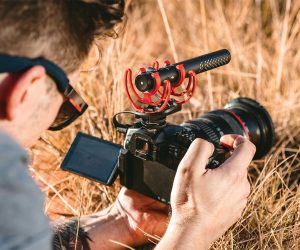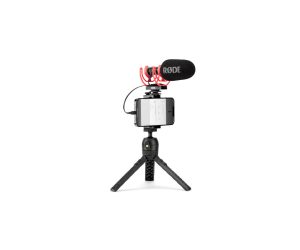
Review: RØDE NTG-1, NTG-2 & VideoMic
Sound recordist extraordinaire Paul Brincat puts the new Rode shotgun microphones into ‘action’ like few others can.
Review: Paul Brincat
It’s not every day a new range of shotgun mics hit the market. As a location sound recordist in film and television production I’ve been working with a small collection of high-end microphones for decades now. Rode’s newly developed shotgun mics – particularly the NTG-1, NTG-2 – are squaring up against these trusty ‘tools of the trade’ and I was intrigued as anyone to see how they’d fare.
In the role of a location sound recordist you have to work in many less-than-ideal situations. Background sound and windy conditions are often biggest obstacles my microphones and equipment must strive to overcome. There again, if it’s not Mother Nature making my life difficult, it’s the sets and film-making machinery, which sometimes offer very little help or sympathy in the way of ‘noise’ minimisation. Despite this, a good sound recordist is always striving to capture the best dialogue recording possible.
On set I usually prefer to use a shotgun mic for its clarity, background rejection and ability to handle harsh weather conditions (‘harsh’, in most cases, usually meaning, ‘windy’). These environments are typically hostile to the recording of pristine sound, so the ‘gagging’ and mounting of these mics is always of great importance. In the tests I conducted with the Rode NTG-1 and NTG-2 – gagged in their (supplied) WSVM windshields and suspended in different members of Rode’s SM range of shockmounts – they faired very well, proving themselves worthy candidates for film and location sound recording duties. Believe me, over the years I’ve heard every creak imaginable from suspension systems, particularly when under very quiet conditions, and to this end the Rode SM shockmounts were very effective.
NTG-1
The first mic I tested was the NTG-1, a very handsome little shotgun indeed. As I record mostly film and television productions, I found the NTG-1 a very sensibly proportioned mic for shooting. Some film/TV sets offer very little in the way of ceiling height and when using a mic on a fishpole, size really does matter. The NTG-1 also performs very well when it comes to clarity and off-axis rejection. These characteristics are of great importance to all feature and documentary sound recordings and the NTG-1 is definitely a very suitable mic for such tasks. Its frequency response of 20Hz – 20kHz and its selectable high-pass filter of 80Hz (which rolls off at 12dB/octave) puts this mic well with broadcast spec. As such, for ENG [Electronic News Gathering] work and documentary recording, the NTG-1 would be a fine choice.
The NTG-1’s super-cardioid pickup works reasonably well, although my choice for a longer ‘reach’ would be the Rode Shotgun NTG-2 as its pattern has greater focus and off-axis rejection (more on the NTG-2 shortly). However, for sound recording work on close-up (C/U) to mid shots, the more forgiving off-axis response and versatility afforded by the NTG-1 would be my choice. I might add that the NTG-1 tolerates high-level peaks very well. For example, when someone unexpectedly shouts – something that can catch you out when recording an EPK [Electronic Press Kit] or drama performances without rehearsals – you really need a mic with that extra ‘headroom’.
In the case of general atmospheres, be they bird/bush atmospheres or more urban sounds for atmospheric recordings, the NTG-1 works fantastically well, and matched up as a stereo pair it would offer even greater possibilities. The NTG-1 requires P48 phantom, which is fairly standard in today’s portable mixer world, as it is with most high-end cameras. The mic itself also has low handling noise which is a plus, although I still would stress the need for a quality pistol grip to help out when you’re on the run – particularly in the case of an EPK, for example. In all, the NTG-1 has some great characteristics and strikes me as a very worthy investment.
NEED TO KNOW
NTG-2
The NTG-2 exhibits similar characteristics to the NTG-1, although the NTG-2’s casing is physically longer, and its ‘reach’ is improved by its ‘narrower’ polar pattern design. This extra ‘reach’ can be very important when it comes to filming wider-shots where you have to keep the mic further from its source. The NTG-2 is also powered by 48V phantom, but also houses an internal 1.5V AA battery just in case – a lifesaver when using the mic with a portable DAT player or ‘handycam’ camera that doesn’t pack phantom powering. The off-axis ‘window’ of the NTG-2 drops off a little sooner than the NTG-1, which makes for precise boom work in the field, and definitely makes it less forgiving than the NTG-1. However, it’s wonderfully suited to recording bird calls at a distance, vehicles as you follow them in and out of wider shots, or any other sound that’s just a bit more distant. The NTG-2 also has an 80Hz high-pass filter – again, a ‘must have’ in outside recordings. This mic also comes supplied with a foam windshield that is fine for a light breeze. However, I would recommend using a proper gag with additional covers for windier days. The NTG-2 is probably my pick for field mic duties, but my preference for dialogue would be the NTG-1 – it seems warmer in its response and more forgiving off axis, making it a very effective dialogue tracking tool.
VIDEOMIC
Last but not least, in this three-mic review, is the ‘VideoMic’. It comes supplied totally fitted into a grip suspension system that attaches to the hotshoe mounts of the camera. A ‘light breeze’ foam windsock is also supplied with the rig. I was also able to test the (optional) ‘Deadcat’ windsock for the VideoMic, which slips straight over the soft foam and is a must for further wind protection. Rode has also taken into consideration the height of the mount, so when it comes to shooting on the wide-end of the lens you avoid seeing a mic intruding into the top of the frame. Thought has also been given to the design of the suspension. Although I did feel there was perceptible movement within the suspension-cradle that caused a few minor audible bumps. I think a little more strengthening within the bands would possibly help eradicate some of those bumps. All in all, the mount sits well on the camera. As for the mic’s sonic character, it has been designed with a good super-cardioid pickup that’s well and truly needed when it comes to recording someone looking down the lens of the camera at close range. Its frequency response is 40Hz – 20kHz and it also carries an 80Hz selectable high-pass filter. The VideoMic’s off-axis performance is good, particularly when it comes to shooting off the camera position. Although its rejection is a little lacking, in the case of this type of scenario, I think it passes the test. The VideoMic is powered by a 9V battery that, according to the specs, offers up to 100 hours of battery life. The battery compartment is easily accessed which makes great sense, and the mic has a clearly visible LED indicator for describing the battery status.
The VideoMic is pitched at the lower end of the market, which in today’s world is a big and competitive arena. There’s no doubt, however, that it provides superior results to the mics built into a camera package. Although, if possible, a bump up to the NTG-1 mic would surely be a nicer way to go – all depending on your budget, of course.
With these new shotgun mics Rode has done it again. Each represents great value for money and offers a quality recording outcome. The NTG-1 and NTG-2 models would clearly make an outstanding microphone choice to give documentary, EPK crews and lower budget features a great sound result.
















RESPONSES